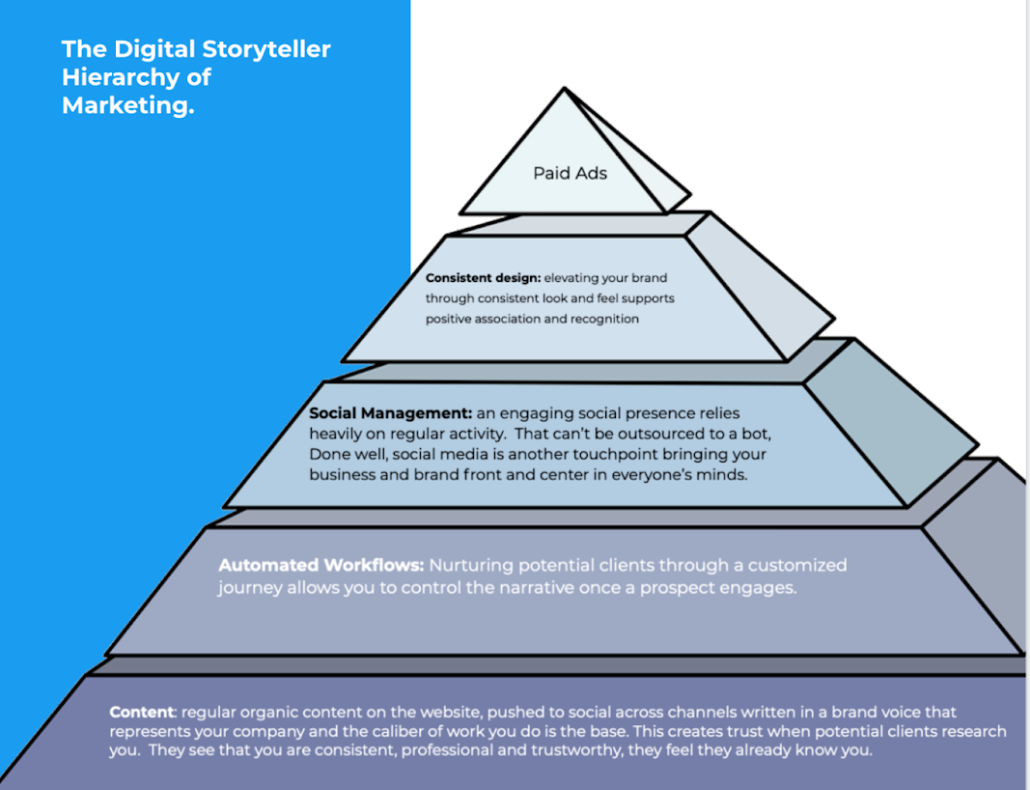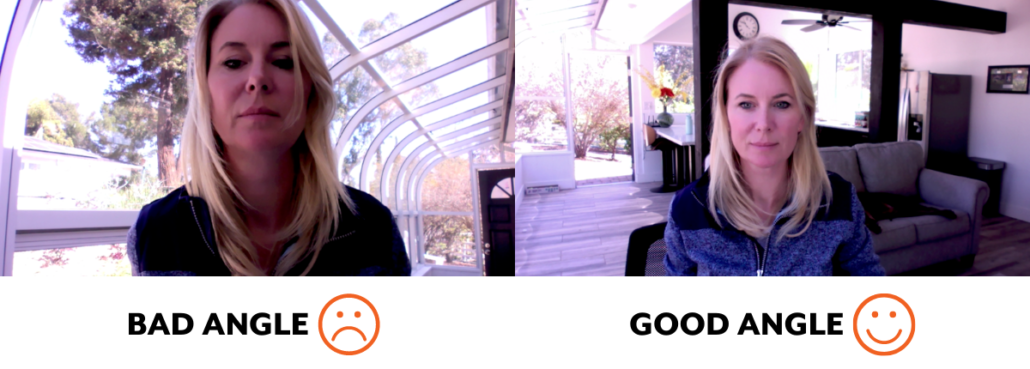How They Work Together
The world of digital marketing is constantly evolving. (We know you know this because we remind you of this in nearly every piece of content we push out!) There are, however, a handful of tried and true marketing efforts under the larger umbrella term of ‘digital marketing.’
Because let’s be honest, not all marketing efforts are created equal. Here we will discuss the top seven categories of digital marketing and how they work together. These seven categories of digital marketing are fundamental to the success of your business’s content marketing strategy.
So, let’s get started.
Content Marketing
First, what is content marketing? Content marketing is the bread and butter of what we do at Digital Storyteller.
Content marketing is “a strategic marketing approach focused on creating and distributing valuable, relevant, and consistent content to attract and retain a clearly-defined audience—and, ultimately, to drive profitable customer action,” as put by the Content Marketing Institute.
Today, the traditional sales pitch style of marketing is decreasing in value every day. Instead, content marketing approaches prospective clients by providing useful, relevant content to help solve problems or answer questions. Furthermore, content marketing aims to build trust with your prospective clients rather than simply complete a sale.
Effective content marketing utilizes the “creating and sharing [of] relevant articles, videos, podcasts, and other media.”
This type of marketing helps to establish expertise and increase brand awareness. The goal is to make sure your business is at the top of your prospect’s mind when the time to purchase a product or service comes.
Search Engine Optimization (SEO)
SEO is another crucial pillar in terms of your digital marketing strategy. SEO, in simple terms, is what allows your content to be found.
For our friends who love definitions, SEO, according to Moz, is “the practice of increasing the quantity and quality of traffic to your website through organic search engine results.” SEO is how marketers tailor their content to appeal to search engines like Google, Yahoo!, and Bing.
For example, you might search ‘affordable chardonnay near me’ on Google. The way that Google then provides results based on your search is determined by SEO. SEO is the tool that tells Google, “Hey! This is what information my website has, this is what I’m talking about, and these are the types of people that would find my website interesting!”
One of our favorite SEO tools to use at Digital Storyteller is Semrush. Semrush is an online tool that collects research on your business’s SEO, pay-per-click (PPC), content, and social media efforts. It can also help you identify keywords you are currently ranking for or targeting.
If you didn’t know, information about ranking keywords is critical to making your way up the Google Search Engine Results Page (SERP).
For more on all things SEO, check out this article for 10 tips to maximize your SEO efforts, this article we wrote on why SEO is important, or one of our more recent articles on how to effectively combine SEO and content marketing!
Search Engine Marketing (SEM)
Parallel to SEO, we have SEM. You guessed it, another crucial piece of digital marketing.
SEM stands for Search Engine Marketing, which is, according to Optimizely, “a digital marketing strategy used to increase the visibility of a website in search engine results pages (SERPs).”
In the past, SEM typically encompassed both organic and paid search. Today, however, it almost exclusively refers to paid search advertising.
SEM is “the act of using paid strategies to increase search visibility.” Every day, businesses pay big money for their ads to rank first on search engine results pages. Hint: You can tell when businesses are using SEM by the bold “Ad” text that accompanies a search result.
SEO, SEM, why so many acronyms?! While these two may seem like the same thing, they are actually quite different. Learn more about the difference between the two in this article.
Email Marketing
Email marketing is not dead. It has, however, become increasingly difficult to grab the attention of clients and prospects through their inboxes.
Email marketing, as defined by MailChimp, is “a form of direct marketing as well as digital marketing, that uses email to promote your business’s products or services.”
Email marketing can be used to promote your latest items and offers, or it can assist with lead generation, brand awareness, relationship building, and customer engagement.
The biggest challenge with email marketing is breaking through the noise. The best email marketing experts:
- Craft compelling campaigns
- Understand optimal audience outreach
- And analyze customer interactions and data
Email marketing software companies, including HubSpot, Campaign Monitor, Constant Contact, and more, help perfect your email marketing campaigns by providing automated email workflow options as well as in-depth email marketing data (i.e. open rates and click-through rates).
Data Analytics
Marketing without data is merely speculation—a guessing game of what you hope will land with your prospects and clients.
At Digital Storyteller, we recognize that data is a crucial part of your digital marketing strategy. When it comes to our analyses, we use Google Analytics (primarily for website data), Semrush (for keyword analytics), and additionally Metricool (to look at social media performance).
Design and Website
As far as design goes, making sure your brand is consistent across all digital and print platforms helps clients and prospects recognize your brand immediately.
Contrary to popular belief, design—whether for marketing collateral, social media, or a website—is more than just pictures and drawings. Venture and Grow state, “Graphic design is the art of communication that requires creativity and a systematic plan to solve a problem or achieve specific objectives.”
So, what makes effective design in digital marketing?
Effective graphic design “highlight plans to discover what makes [content] genuinely stand out and get shared.”
Additionally, top-notch design helps:
- Build trust
- Increase brand awareness
- Influence the customer decision-making process
Don’t underestimate this component’s power in your digital marketing strategy. After all, you could have amazing content that gets swept under the rug because of poor presentation.
Speaking of design, let’s take a moment to chat about your website. Your business’s site isn’t just an opportunity to showcase your branding and design. Whether or not your site is easy to navigate and structured properly has a huge influence on how (and IF) clients and prospects will interact with your brand.
So, take a minute to ask yourself these questions: Is my website easy to navigate? Is it nice to look at? Does it lead people on a journey to find out more about my business?
Social Media Marketing
Of course, social media is a huge pillar in your digital marketing strategy. The platforms that you use (and that are essential to your digital marketing strategy) depend heavily on your target audience. Ask yourself where your prospects spend the most time, and where they are most likely to be influenced to trust a brand.
To learn which social platforms your business should be on, read our article “Financial Services Companies: Which Social Media Platforms Should You Be On?”
Social media marketing includes any content that is released via a business’s social media channels. When it comes to a business, however, it’s not all fun and games. Crafting the perfect social media marketing strategy to fit into your larger digital marketing strategy is more complicated than posting on your own Instagram or LinkedIn.
Social media marketing is integrated and strategic. It takes hard work. Everything that pushes to social media must mirror the messages that are used throughout your business.
Social Media Analytics
Analytics are also crucial to your social media marketing.
This data can help you discover what types of posts do or don’t do well and why. With this data, social media marketers can better tailor their strategies for their business’s benefit.
Digital Storyteller is Here to Help
We know, there is a lot that goes into a successful digital marketing strategy. At Digital Storyteller, we like to think of your digital marketing strategy as a giant system of gears working together. Content is at the heart of this system and drives all of the marketing components like SEO, SEM, social media marketing, and so on.
The system would fail without each gear in place. So, how does your digital marketing strategy measure up? Read on to learn how to measure the success of your digital marketing strategy. You might be surprised by how your business is really doing.



















